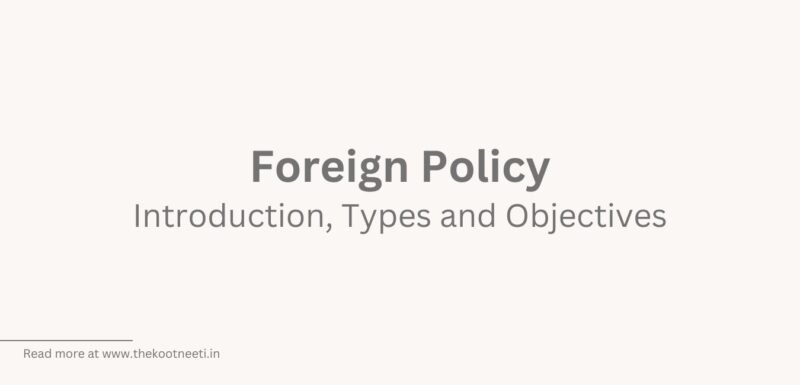Foreign Policy: Introduction, Types and Objectives

Foreign policy refers to the actions and decisions taken by a country or other actor in relation to its interactions with other countries and actors in the international system. It encompasses a wide range of issues, including economic relations, security and defence, political and cultural interactions, and environmental and humanitarian concerns.
Foreign policy is shaped by a variety of factors, including a country’s national interests, values, and resources. It is often developed and implemented by the country’s government, although other actors, such as civil society organizations, businesses, and individuals, may also play a role in shaping foreign policy.
Foreign policy is an important aspect of international relations, as it determines how a country or other actor engages with the rest of the world and how it seeks to achieve its goals and interests in the international system. It is also a key factor in shaping the relationships and interactions between countries and other actors, and it can have significant consequences for global peace and stability.
Types of foreign policy
There are several different types of foreign policy, which can be classified based on their goals and approaches. Some common types of the foreign policy include:
- Offensive foreign policy: This type of foreign policy involves aggressively pursuing one’s own interests at the expense of other countries. It may involve the use of military force or other forms of coercion.
- Defensive foreign policy: This type of foreign policy is focused on protecting a country’s interests and preserving its independence. It may involve building up military capabilities or forming alliances with other countries.
- Cooperative foreign policy: This type of foreign policy involves working with other countries to achieve common goals. It may involve negotiations and compromise in order to achieve mutually beneficial outcomes.
- Isolationist foreign policy: This type of foreign policy involves limiting a country’s involvement in international affairs and avoiding entanglements with other countries.
- Interventionist foreign policy: This type of foreign policy involves actively intervening in other countries’ affairs, often promoting democracy or human rights.
- Multilateral foreign policy: This type of foreign policy involves working through international organizations or coalitions in order to achieve foreign policy goals.
Also Read: Top Challenges for Indian Foreign Policy in 2023
The objectives of foreign policy vary depending on the country and its specific circumstances, but some common goals include:
- National security: Ensuring the safety and security of the country and its citizens is a major goal of foreign policy. This may involve building up military capabilities, forming alliances with other countries, or engaging in diplomatic efforts to prevent conflicts.
- Economic development: Many countries seek to promote economic growth and development through their foreign policy. This may involve negotiating trade agreements, promoting investment, or seeking access to resources.
- Political stability: Foreign policy can be used to promote political stability both within a country and abroad. This may involve supporting democratic governments, helping to mediate conflicts, or promoting human rights.
- Protecting national interests: Countries often seek to protect their own interests through their foreign policy. This may involve defending territory, preserving access to natural resources, or promoting the country’s values and ideology.
- Influencing international relations: Foreign policy can be used to shape international relations and shape the global order. This may involve promoting certain values or principles, such as democracy and human rights, or seeking to influence the behavior of other countries.
Indian Foreign Policy
India’s foreign policy has traditionally been guided by the principle of non-alignment, which means that it has sought to maintain a position of neutrality in global affairs and to avoid aligning with any particular bloc of countries. However, India’s foreign policy has also been shaped by its own national interests and by its desire to play a larger role in global affairs.
In recent years, India’s foreign policy has been marked by an increasing focus on economic engagement and strategic partnerships. India has sought to strengthen its economic ties with other countries, particularly through trade and investment, and it has also sought to build strategic partnerships with other major powers, such as the United States, China, and Russia. India has also been active in regional organizations, such as the South Asian Association for Regional Cooperation (SAARC) and the Association of Southeast Asian Nations (ASEAN), and it has played a role in global efforts to address issues such as climate change and terrorism.
Also read: Six Phases of Indian Foreign Policy



















